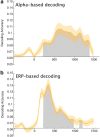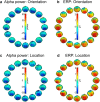Dissociable Decoding of Spatial Attention and Working Memory from EEG Oscillations and Sustained Potentials
- PMID: 29167407
- PMCID: PMC5761617
- DOI: 10.1523/JNEUROSCI.2860-17.2017
Dissociable Decoding of Spatial Attention and Working Memory from EEG Oscillations and Sustained Potentials
Abstract
In human scalp EEG recordings, both sustained potentials and alpha-band oscillations are present during the delay period of working memory tasks and may therefore reflect the representation of information in working memory. However, these signals may instead reflect support mechanisms rather than the actual contents of memory. In particular, alpha-band oscillations have been tightly tied to spatial attention and may not reflect location-independent memory representations per se. To determine how sustained and oscillating EEG signals are related to attention and working memory, we attempted to decode which of 16 orientations was being held in working memory by human observers (both women and men). We found that sustained EEG activity could be used to decode the remembered orientation of a stimulus, even when the orientation of the stimulus varied independently of its location. Alpha-band oscillations also carried clear information about the location of the stimulus, but they provided little or no information about orientation independently of location. Thus, sustained potentials contain information about the object properties being maintained in working memory, consistent with previous evidence of a tight link between these potentials and working memory capacity. In contrast, alpha-band oscillations primarily carry location information, consistent with their link to spatial attention.SIGNIFICANCE STATEMENT Working memory plays a key role in cognition, and working memory is impaired in several neurological and psychiatric disorders. Previous research has suggested that human scalp EEG recordings contain signals that reflect the neural representation of information in working memory. However, to conclude that a neural signal actually represents the object being remembered, it is necessary to show that the signal contains fine-grained information about that object. Here, we show that sustained voltages in human EEG recordings contain fine-grained information about the orientation of an object being held in memory, consistent with a memory storage signal.
Keywords: EEG; ERP; alpha; decoding; orientation; working memory.
Copyright © 2018 the authors 0270-6474/18/380409-14$15.00/0.
Figures









References
-
- Bisiach E. (1996) Unilateral neglect and the structure of space representation. Curr Dir Psychol Sci 5:62–65. 10.1111/1467-8721.ep10772737 - DOI
Publication types
MeSH terms
Grants and funding
LinkOut - more resources
Full Text Sources
Other Literature Sources
